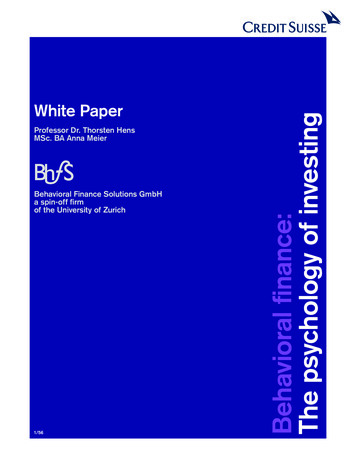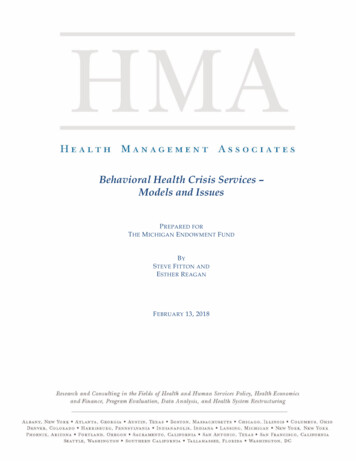
Transcription
Professor Dr. Thorsten HensMSc. BA Anna MeierBehavioral Finance Solutions GmbHa spin-off firmof the University of Zurich1/56Behavioral finance:The psychology of investingWhite Paper
White PaperThe psychology of investingAuthorsResearch conduced byProfessor Dr. Thorsten Hensand MSc. BA Anna Meierfrom Behavioral Finance Solutions GmbHEdition2016Credit Suisse AGParadeplatz 88070 ZurichSwitzerlandwww.credit-suisse.comWe are delighted to present to you Behavioral Finance:The Psychology of Investing, a White Paper that was developedin collaboration with The University of Zurich. This report aimsto provide you with insight on the emotional and psychologicalinfluence that can impact our financial decisions, and howit can result in irrational behavior. It further explores waysto avoid the pitfalls that investors commonly face.Behavioral finance is a fairly novel topic which has gainedprominence since the early 1990s. This can be creditedto Amos Tversky and Daniel Kahneman, who were notablefor their development of Prospect Theory in behavioralfinance. Kahneman won the 2002 Nobel Memorial Prizein Economic Sciences for the work he did in this areawith Tversky, who died in 1996. A big part of investment ispsychology and if investors can understand the psychologicalaspects, it could potentially prevent any financial drawbacks.Behavioral finance has managed to bridge the gapbetween theory and practice by scientifically recordinghuman behavior. To date, research has focused on theideal scenario of thoroughly rational investors in efficientmarkets, while reality is dealing with day-to-day irrationalinvestor behaviors and inefficient markets. Combining theoryand practice allows us to use the findings from behavioralfinance as fundamental elements of advisory services,asset management, and financial product development.ContentsOrientation5Milestones of portfolio theory7Behavioral biases14Cultural differences in investor behavior24Neurofinance: a new branch of behavioral finance 32Market anomalies34Investment advisory services38Conclusion51Authors52Resources53At Credit Suisse, our holistic approach to providing clientswith wealth management advice transcends the traditionalfinancial advisory relationship. Our five-step advisory processenables us to thoroughly understand our clients' needs andtheir rationale in making any financial decisions, in additionto assessing their risk appetite and behavioral bias.Credit Suisse has had the privilege of serving many ofthe world’s wealthiest individuals and families since 1856,which shows our commitment to the needs of our clientsand the needs of society.We hope you find this White Paper a source of insightand relevance.Copyright 2016 Credit Suisse Group AG2/563/56
OrientationThis White Paper is divided into six sections. Ideally, theseshould be read in sequential order.The figure below shows which sections are required readingfor other sections. Naturally, the introduction to each sectionis important. However, should readers choose to skipthe remainder of the sections, only the section on marketanomalies will be difficult to understand unless they havesolid background knowledge. Behavioral Biases is thebasis for Cultural Differences, which in turn is the basis forNeurofinance. Finally, Behavioral Biases is also particularlyfundamental to Investment Advisory Services.Figure 1. OrientationIntroductionBehavioral biasesCultural differencesNeurofinanceMarket anomaliesInvestment advisory servicesThe small arrows show the normal reading pattern.The large arrows show the prerequisites, i.e. at these points,the reader should refer back to the indicated sections.4/56Orientation5/56
Milestones of portfolio theoryWhile the present functions without the past, we canunderstand it better if we look at its historical developmentsstep by step. The same is true for financial market research.This currently comprises fairly complicated mathematicaland psychological models that, at first glance, can seemquite confusing. The figure below shows the milestonesof portfolio theory, one of the primary areas of financialmarket research, over time.Figure 2. Milestones of portfolio theory1600170018001900Kahneman and Tversky (1979):Portfolio TheoryHarry Markowitz (1952):Mean Variance ModelVon Neumann and Morgensten (1944):Utility Function (prescriptive)Daniel Bernoulli (1738):Utility Function (descriptive)Blaise Pascal (1670):Expected ValueThe first person to focus on how we make decisions inuncertain situations was French mathematician Blaise Pascalin 1670. He looked at fairly simple situations and wondered,for instance, what would be preferable:a)b)a coin toss in which one could win 6 francsfor heads — and only 2 francs for tails —or another coin toss in which one could win9 francs or 1 francHis suggestion was to make the decision based onthe expected value, i.e. the average payout.6/56Milestones of portfolio theory7/56
Figure 3. Sample coin tossFigure 4. Utility function for various level of risk aversion6Standard deviation: (6-2)/2 2Mean, expected value: (6 2)/2 42α 1α 0.59Standard deviation: (9-1)/2 4UtilityMean, expected value: (9 1)/2 51For the first coin toss, the expected value is 4, for the secondcoin toss, it is 5. Therefore, in Pascal’s view, one shouldchoose the second coin toss. Daniel Bernoulli, a mathematicianfrom Basel, had the same idea when his brother Nikolaustold him about the St. Petersburg game more than onehundred years later. Under Blaise Pascal’s theory, the citizensof St. Petersburg should wager every cent they had to playthe St. Petersburg game, because it had an infinite expectedvalue. This contradicted the observations of Nikolaus Bernoulli,which revealed an average payout of 2 ducats. The averagepayout of 2 ducats may seem like a paradox at first, but isexplained by Daniel Bernoulli’s generalization of the theoryon calculating the expected payout. Bernoulli’s function,as applied to Pascal’s theory, is now known as the utilityfunction. The utility function refers to a fundamentalpsychological law, the diminishing marginal utility of money.Capital Profit/lossOr, as Daniel Bernoulli said: “There is no doubt that a gainof one thousand ducats is more significant to the pauperthan to a rich man though both gain the same amount.”It is important to notice that the diminishing marginal utilityof money embodies the risk aversion of the person makingthe decision. A decision-maker is averse to risk if, insteadof a random payout, he prefers the certainty of the expectedfixed payout from a game.The St. Petersburg game shows that the people ofSt. Petersburg were averse to risk. Let us imagine someonemade a decision and received the expected payout.If he chose to gamble instead, in some cases he would winmore, and in other cases he would win less. Due to themoney’s diminishing marginal utility, the utility of the higherpayout would be lower than for a reduced payout. This is whyit is more rational to take the average payout with certainty.xaFigure 4 shows the utility function u(x) α for variouslevels of risk aversion, α1. The larger parameter α, the lessrisk averse the decision-maker.With the expected utility hypothesis a method of calculationhad been found to explain a variety of observed behaviors2.In 1944, mathematicians John von Neumann andOskar Morgenstern determined that the expected utilityhypothesis is also the only criterion that allows people tomake rational decisions in uncertain situations. Every othercriterion contradicted plausible fundamental conditions forbehavior, known as axioms.One example for these axioms of rational behavior is theaxiom of independence, which states that when choosingbetween two lotteries, only the differing aspects ofthe lotteries should be considered.128/56Milestones of portfolio theoryFor instance, two lotteries could each be based on throwingone die. Neither lottery has a payout for an odd number.The first lottery (A) has a payout for each even number,in the amount of the number cast.The second lottery (B) has the following payouts: a payoutof zero for a two, a payout of four for a four, and a payoutof ten for a six.The axiom of independence now states that when selectinga lottery, we can limit ourselves to those cases in whichthe two or the six is cast, because the payouts of bothlotteries are identical in all other cases. Thus, the selectionis reduced to whether the player wants two and six, or zeroand ten, with the same probability.A risk aversion of α 1 denotes a risk-neutral investor.In the example shown in Figure 3, for all levels of risk aversion α 0.326the right coin toss is chosen. While for alpha 0.326 the left one ischosen. For a risk aversion of 0.326, both games are equal.This is calculated based on the. The result is 60.326 20.326 9 0.326 10.326.Milestones of portfolio theory9/56
Figure 5. Axiom of independenceFigure 6. Risk-return diagramOutcome123456Lottery A020406Lottery B0004010Efficient olioCapitalprotectionproductMean (return)BondsSD (risk)So had everything been figured out by the middle of the lastcentury? The expected utility hypothesis was flexible enoughto illustrate different behaviors in uncertain situations andwas also the only sensible manner of proceeding in suchsituations. Unfortunately, there was a significant weak spotin this hypothesis: Where to find realistic probabilities forcalculating the expected utility if it was not a coin toss?For instance, how can we define the probabilities of returnson asset classes such as bonds, equities, or alternativeinvestments, or even single securities within a class?These returns depend, among other things, on economicfactors such as the economy itself, monetary policy,innovation, and growth, alongside the behavior of otherstakeholders. The sum of these aspects results in an almostimpossibly tangled mass of interactions. To unravel thisGordian Knot, Eugene Fama developed his efficient markethypothesis, which had its predecessors in the 1950s.If all market participants thought constantly about the factorsbehind the returns on securities, and then developedtrading strategies to make money based on these factors,the buying and selling decisions of these trading strategieswould ensure that all profitable information about the decisivefactors would be priced into the securities at all times.The market anticipates every predictability in the prices.The remaining price developments result from previouslyunanticipated changes to the factors, surprise information.Because surprises are inherently impossible to predict, theprices of securities develop by pure chance, i.e. statisticallyindependent of one another. We know from statisticsthat the sum of random variables can be defined by normaldistribution (bell curve). The distribution is well-definedby its mean and its standard deviation.The efficient market hypothesis is a brilliant simplificationof decision-making in uncertain situations, because thesethen would depend only on the mean and the standarddeviation of the distributions. In 1952, Harry Markowitz builton this idea to develop his mean variance model, whichwas also based on only two aspects, namely returns,measured by mean, and risk, measured by its standarddeviation. It was clear to Markowitz that investors preferreda high average return with a low risk. As we saw from thetwo coin tosses in Figure 3: For the first toss, the averagepayout is 4, the standard deviation is 2; for the second,the average payout is 5 and the standard deviation is 4.Depending on risk tolerance (here, the aversion to fluctuatingreturns) the decision-makers will choose the first or the secondcoin toss. Therefore, Markowitz presented the variousinvestment options in a return/risk diagram such as the onein Figure 6.As we can see in Figure 6, when the average return (mean)increases, the expected risk (standard deviation) of aninvestment also increases. For each return level indicated,an investor can minimize his risk by diversification.This sequence of minimization problems results in the efficientfrontier, which denotes the minimum risk for a given returnlevel. Depending on the individual risk tolerance of an investor,the best portfolio can be selected on the efficient frontier(see Figure 6).Behavioral finance is the newest chapter in the historyof portfolio theory. Why do we yet need another theory?Behavioral finance explains the typical mistakes (behavioralbiases) made by investors. Secondly, it provides a detailedpicture of investors’ risk preferences. This second aspect iscovered by Daniel Kahneman and Amos Tversky’s prospecttheory (1979). Unlike the Markowitz analysis, prospecttheory focuses on the significance of investment losses.Kahneman and Tversky found in their studies that mostinvestors are averse to loss. This means that investmentlosses have to be compensated through the opportunity forhigher returns. For most investors, these must be at leasttwice as3 high as the potential loss.The utility function of the prospect theory is shown in Figure 7.Maximizers of prospect utility evaluate the results oftheir investments using a reference point. This can bethe purchase price of a security, for example. Loss aversionis reflected in the fact that the utility function initially hasa much steeper curve than the profit area. The prospectutility theory takes from the expected utility theorythe characteristic of declining marginal utility of the gains.The loss area reflects the declining marginal damage ofthe losses. This is demonstrated by the fact that prospectutility maximizers would risk something for a break-evenopportunity rather than face a definite loss.Thus, they prefer a random payout to the expected utility310/56Milestones of portfolio theoryTo be precise, it is 2.25 times higher.Milestones of portfolio theory11/56
Figure 7. Utility function of the prospect theoryFigure 8. The behavioral efficient frontier based on the prospect theoryυ(Δх)Behavioral tPrice-dividendratioGainCapital protection productProfit-β(-Δх)αLossif it is negative. If markets were efficient as per Fama’stheory, all investment returns would have a normal distributionand the application of the mean standard deviation criterionwould still be justified for prospect theory investors.In reality, the efficient market hypothesis is not valid, so veryfew investments have returns with normal distribution.For this reason, the loss aversion under the prospect theoryis key to an optimal portfolio. We must replace the efficientmarket line in the mean-standard deviation model with abehavioral efficient frontier based on the prospect theory.The behavioral efficient frontier was first developed in a paperby De Giorgi, Hens, and Mayer (2011). It depicts prospecttheory using a risk-return diagram. The results of an investmentare broken down into those cases where investments makea profit and those where the investments make a loss.The degree of loss aversion determines the selection ofan optimal portfolio on the behavioral efficient frontier,as shown in Figure 8. If we compare portfolios based onthe prospect theory with the Markowitz portfolios, we seethat these have a lower portion of equities and hedge fundswhile weighting capital protection products more heavily.Equities and hedge funds are not heavily represented inthe prospect portfolios, because of their potential high losses.On the other hand, capital protection products are not verycommon in the Markowitz portfolios. Although they do not12/56Milestones of portfolio theoryshow a loss as long as the counterparty does not default,they have varying levels of returns and thus a standarddeviation. Practice has often shown that clients whoseportfolios were based on the Markowitz theory did not adhereto their investment strategy when the markets declined.As a result, they usually missed the rebound and performancewas lower than if they had maintained their strategy.Thus, it is worth choosing a prospect theory, so that investorscan stick to the strategy both in financial and emotional terms.As a result, investment advice based on current researchfindings must optimally position prospect theory investorsfor inefficient markets.Milestones of portfolio theory13/56
Behavioral biasesThe cyclical investment process – including informationprocurement, stock picking, and investing, holding, andselling investments, followed by a new selection – is fullof pitfalls. These can come at a high price to investors inthe literal sense of the word. As Benjamin Graham liked tosay, “The worst enemy of the investor is most likely himself.”Investment purchases are a rapid-fire process, and the valueof these investments can decline just as rapidly – even tozero, of course, making them a waste of money.In this section, we will illustrate each step of the processand explain the potential pitfalls. In the next section, we willshow how you can avoid these pitfalls with the help ofCredit Suisse’s investment advisors and investment processes.Let us start from the beginning – the investment roller coaster.Figure 9. Investment process – Roller coaster of emotionsThankfullyI didn't waitto buy!Ah, I see a trend.I should watchthis marketI will use this correctionto increase my position.BUYIf I wait any longerI would not profitfrom the trend.BUYWow! At this priceI will double my position!BUYI can't believe it! The pricehas now halved. This mustbe the absolute bottom!Why doesn't thebanking associationhave anything to sayabout this?Enough is enough!I should sell and neverlook at stocks again!SELL14/56Behavioral biasesWhatever, I will buy again!Anyway, it's cheaperthan last time.BUYAh, it will keep falling.I knew all alongthat it wouldrecoverWhat is goingon here?What did I say.Luckily I sold everything!The markets are on the rise, the stock exchanges areregistering record highs, and the media reports this to readersin diluted form. Business journalists report on innovative,creative companies that are all making a profit in these markets.However, they fail to see that not all companies are successfulusing those same criteria. Thus, they do not falsify the theory,a mistake known as the confirmation bias. We cannot avoidreading the headlines about price gains and booming markets,or the multitude of success stories. These stories attractthe interest of many (amateur) investors. Readers followdevelopments in the bull market with bated breath; with somehesitation and a little safety distance, they make note of certainstock markets and shares. If the media spotlights a particularstock, it is more likely to attract investor attention. After a certainamount of watching from the wings, some investors feel aneed to actively invest in order to participate in the uptrendbefore it is too late. With the wind of so many successstories beneath their sails, there is (almost) no chance ofour investors failing. So the survival error has taken hold.The media and its readers love to write and talk aboutsuccess stories: looking at the gossip magazines while atthe hairdresser, for instance, we see it is all glitz and glam.However, these are not the only publications featuringthe rich and famous – wealthy entrepreneurs, writers,celebrities, singers, and other people who have made it.Of course, there is never any mention of the hundreds ofthousands, even millions, of people who haven’t succeeded.As a result, we grossly overestimate the stellar achievements,which are as unlikely as a winning lottery ticket. Investorsalso fall victim to induction. They see a security rise and rise,until they are certain that it can only get better. Often theyinvest a large portion of their assets in this security – resultingin a serious cluster risk – and are likely to lose it all. It is a bitlike a Christmas goose believing in the good of humanityand still getting the ax in the end.easier to remember than statistical figures, for instance.This distorts our perception between the frequency distributionand statistical reality. As a result, investors never chooseinformation from the other side of the fence but always basedon their experiences and preferences. This means thatwe are more likely to recall the front page of a newspapershowing a CEO racing down the Côte d’Azur in his convertible;maybe you have to change the domicile depending on thetarget group (customers). We are less likely to rememberthat his company’s net profit margin dropped by 30%and its earnings by 18%. Investors make positive associationswith the company, because they liked the car, or the CEOhad a nice smile in the photo. They may also rememberthe CEO’s attractive companion with her bright red lipstick.The image in their head is a good one, and so is their impressionof the company. Typical investors evaluate informationaccording to how quickly it can be recalled. This meansthat in most cases, we do not continue to think ofalternatives, because we are satisfied with our initial thought.Investors who remember the CEO in his convertible associatethe company with success, and think it would be a goodinvestment. They may also remember a company advertisementor the make of car driven by the villain in an action moviethey just saw. As soon as we remember a promising company,we begin to support our opinions with other publicly accessibleinformation. This is not very rational, as the process doesnot permit a differentiated view. Once an investment haswon the investor over, he often makes the mistake oflooking for only positive information. We made referenceto this at the beginning of this section with the businessjournalists’ reports. The Confirmation bias is the phenomenonof supporting our own opinions with selective information.Investors seek confirmation for their assumptions. They avoidcritical opinions and reports, reading only those articlesthat put the product in a positive light.Because investors don’t know they have fallen into the trap,they try to find a good investment and look for familiar companynames. In situations like these, it is very hard to avoidthe availability/attention bias. Events that come up morefrequently (often with additional media coverage) remain inour minds more than events that come up less frequently.We forget that there are other scenarios. On the other hand,rare events that attract heavy media attention (dramatic events)are overestimated, as can be seen in the following example.If we ask a random person what the most common causeof death is, he or she might say getting eaten by a shark, orkilled in a plane crash or during a hold-up. This is becausethe media pounce on these sensational causes of death,which stay in our minds whether we want them to or not.What is more, illustrated, easy-to-digest information isOur investor’s boss is also interested in market developmentsand likes to talk about the bull market during his coffee breaks.He recommends investing in the pharmaceuticals industry.Because the investor is afraid to contradict him, or wouldnot even think about it, he begins to do some research.The coffee break scenario is a good example of the authoritypitfall that our investor falls prey to. He considers his bossan authority and would never dare to disagree with him.However, the boss is no more or less correct than hisemployee. Because our investor does not know about thisbias (or that he has succumbed to it), he now wants to researchthe earnings of three Swiss pharmaceutical companies overthe last few years. As he looks for information, he also reviewsthe returns on the company’s stock over the last few years.Too bad that he looks only at the last three years.Behavioral biases15/56
He does not have the profits handy for one company, but seesthat revenues have grown steadily over the last three years.He concludes that profits will continue to grow in the futureand that the company must be successful. Investors do nottend to use representative data. This means that the timeperiod shown by the data is too short to determine thestatistical population and thus it is not possible to drawconclusions about the statistical population. In the abovecase, it would be wrong to draw conclusions about the entireindustry based on an analysis of three companies.Moreover, one to three years is too short a time period todraw a valid conclusion.We refer to these cases as the law of small numbers.You may remember learning about the law of large numbersin school. If we toss a coin enough times, the numberof heads will be essentially equal to the number of tails.Unfortunately, we often believe that this equality is verylikely to apply to smaller random samples. As a result, basedon just a little information, we look forward to high returnsand presume that the world in general is looking up. back tothe roller coasterWhile looking for the profits of the pharmaceutical company,our investor finds an interesting article in a reputable businessjournal. It reports on a Swiss company with a 40% chanceof generating a 5% excess return over the SMI. He is soexcited that he decides to invest in this company. He probablywould not have done so if he had read in the paper that therewas a 60% chance of the company generating a less than5% excess return over the SMI. He has just fallen for theframing effect.This means that how something is presented will influenceour decisions. For instance, there is a huge difference inwhether a sum is presented as a loss or a missed profit,even if these mean the same thing. Therefore, our decisionsare based largely on how they are depicted. The choice ofscale on a chart is seldom random. It is chosen intentionallyto influence the desired result as much as possible.These types of framing effects apply to everything in life.Imagine our investor is having dinner at a friend’s houseand she tells him that she made the sauce with 80% fat-freecream. Do you think she would have bought this cream ifthe package said cream with 20% fat? This would also workif it said 98% fat-free as compared to 2% fat. Most peoplewould choose the 98% fat-free product even though factually,16/56it has more fat than the product with 2% fat. Since he savedso many calories with the meal, our investor should treathimself to another beer. Imagine the beer bottle says 3.9%alcohol – how do you think consumers would feel about alabel that said 96.1% water? This means that a company’spresentation of a product is never random. It is usually intendedto serve the seller’s purpose, which does not always conformto the buyer’s purpose.Because our investor doesn’t really care about cream sauce,he changes the subject and boasts about the investmentshe made in the stock market. He tells his friend that heinvested in high-growth, successful companies, so hepurchased equities from Roche, Novartis, Geberit, Holcim,Nestlé, Synthese, Google, Facebook, and Credit Suisse.As he moves down the list, he does not realize most ofthese shares are country specific or target customer specific.The home bias is to blame. According to this bias, mostinvestors choose the majority of their equities from theirhome country. These stocks seem more trustworthy,and we grew up with these company names. They are alsomentioned more frequently in the local media. This is onereason investors do not diversify enough, but it’s far frombeing the only reason.Once we invest in a stock, we hope the price will go up butare afraid it will go down. Of course, price developmentsdepend on chance. In psychological terms, what countsis how we handle them. First the price goes up and theoptimists feel their decision was the right one – they think,“Thank goodness I didn’t wait any longer.” However, ourinvestor is not the only one, and everyone wants to be partof the boom (herd instinct). This includes the pessimists, whofeel lucky each time the price increases. This herd instinctis rooted within us and, once upon a time, was necessaryfor our survival.After an uptrend phase – a phase of hoping for big profits,for instance, the price begins to drop. The optimists wouldsay that these price losses are bad luck, or a necessarycorrection. The pessimists would be furious if they suffereda loss. We can imagine that pessimists do not remain investedfor long – unless they are masochists. This is why the stockmarket tends to have more optimists, who frequently investon the principle of hope. This means they invest in stockssuch as innovative technologies that have a low probabilityof generating enormous returns. Because this is typicalbehavior in sports bets, we call it the favorite long shotbias. People who fall into this psychological trap always beton the long shot, because it promises very high returns.Unfortunately, they forget that the likelihood of the longBehavioral biases17/56
shot winning cancels out the profit in the middle. Of particularinterest is the typical investor behavior in cases of long-termloss, when the downward spiral persists and the pricesplummet – a bear market. On the one hand, investors willinitially ignore all the information about a downward trend,because it does not support their preconceived notionthat the investment is good and that there is an uptrend.Another common, irrational response is to buy more stockbecause: “I’m taking advantage of the correction andreinforcing my position” or even: “Great, I’ll double my positionat this price.” This behavior is caused by contrast andanchoring. When making these decisions, investors donot rely on fundamental factors. Rather, they tend to basetheir decision on the price at which the original or last positionin a stock was purchased. This price – also known asthe acquisition cost – is the unfortunate anchor and causesthe irrational decisions. Unlike the acquisition cost, the newprice seems cheap to the investor.Anchoring influences individual decisions based on the factthat investors do not realize how the information is present
made a decision and received the expected payout. If he chose to gamble instead, in some cases he would win more, and in other cases he would win less. Due to the money's diminishing marginal utility, the utility of the higher payout would be lower than for a reduced payout. This is why it is more rational to take the average payout with .











